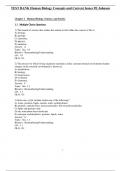TEST BANK Human Biology Concepts and Current Issues 9E Johnson
Chapter 1 Human Biology, Science, and Society
1.1 Multiple Choice Questions
1) The branch of science that studies the natural world within the context of life is
A) biology.
B) geology.
C) chemistry.
D) physics.
E) medicine.
Answer: A
Topic: Sec. 1.0
Bloom's: Remembering/Understanding
LO: 1.0
GLO: G1
2) The process by which living organisms maintain a fairly constant internal environment despite
changes in the external environment is known as
A) metabolism.
B) biology.
C) homeostasis.
D) evolution.
E) chemistry.
Answer: C
Topic: Sec. 1.1
Bloom's: Remembering/Understanding
LO: 1.1
GLO: G1
3) Molecules of life include which one of the following?
A) water, proteins, lipids, nucleic acids, carbohydrates
B) proteins, saturated fats, monosaccharides, but not polysaccharides
C) lipids and proteins only
D) any noncarbon based molecule
E) nonsugar carbohydrates, proteins, lipids, water
Answer: A
Topic: Sec. 1.1
Bloom's: Remembering/Understanding
LO: 1.1
GLO: G1
1
,4) Which one of the following is a TRUE statement?
A) Molecules are considered to be the smallest unit capable of exhibiting all the characteristics
of life.
B) Cells arise spontaneously from nonliving chemical elements.
C) All living things are made up of at least one cell.
D) Individual cells are incapable of maintaining homeostasis.
E) Unicellular organisms are too small to respond to their environment.
Answer: C
Topic: Sec. 1.1
Bloom's: Remembering/Understanding
LO: 1.1
GLO: G1
5) Which one of the following is a CORRECT statement regarding metabolism?
A) Few living organisms require raw materials and a constant source of energy.
B) Plants get the raw materials they need for life processes entirely from the air.
C) Cells maintain life through the breakdown of molecules and energy by chemical and physical
processes.
D) Cells do not require energy to change molecules from one form to another.
E) Animals use energy obtained directly from the sun and chemicals obtained from plants, other
animals, air, and water.
Answer: C
Topic: Sec. 1.1
Bloom's: Remembering/Understanding
LO: 1.1
GLO: G1
6) All of these criteria are used to classify an organism as a member of the plant, animal, or fungi
kingdom EXCEPT which one?
A) the organism's life cycle
B) whether or not the cells of the organism have nuclei
C) the organism's structure or body plan
D) how the organism obtains nutrition
Answer: B
Topic: Sec. 1.2
Bloom's: Remembering/Understanding
LO: 1.2
GLO: G1
2
,7) Which one of the following is a kingdom?
A) Eukarya
B) Primates
C) Archaea
D) Animalia
E) Bacteria
Answer: D
Topic: Sec. 1.2
Bloom's: Remembering/Understanding
LO: 1.2
GLO: G1
8)
Based on the figure above, which group of organisms is most closely related to members of the
Kingdom Animalia?
A) Protista
B) Fungi
C) Plantae
D) Bacteria
E) Archaea
Answer: B
Topic: Sec. 1.2
Bloom's: Applying/Analyzing
LO: 1.2
GLO: G3
3
, 9) Which kingdom in the domain Eukarya contains primarily multicellular photosynthesizers?
A) Plantae
B) Bacteria
C) Fungi
D) Archaea
E) Animalia
Answer: A
Topic: Sec. 1.2
Bloom's: Remembering/Understanding
LO: 1.2
GLO: G1
10) In which of the following taxa (subgroups used in classification) do humans belong?
A) Mammals
B) Protista
C) Bipedalism
D) Prokarya
E) Bacteria
Answer: A
Topic: Sec. 1.2
Bloom's: Remembering/Understanding
LO: 1.2
GLO: G1
11) Which one of the following sequences represents taxa arranged in order from largest (most
inclusive) to smallest?
A) kingdom, domain, phylum, order, class, genus, species, family
B) domain, kingdom, phylum, class, order, family, genus, species
C) domain, kingdom, phylum, class, order, genus, species, family
D) family, genus, species, order, class, phylum, kingdom, domain
E) kingdom, phylum, domain, class, order, genus, species, family
Answer: B
Topic: Sec. 1.2
Bloom's: Remembering/Understanding
LO: 1.2
GLO: G1
4




